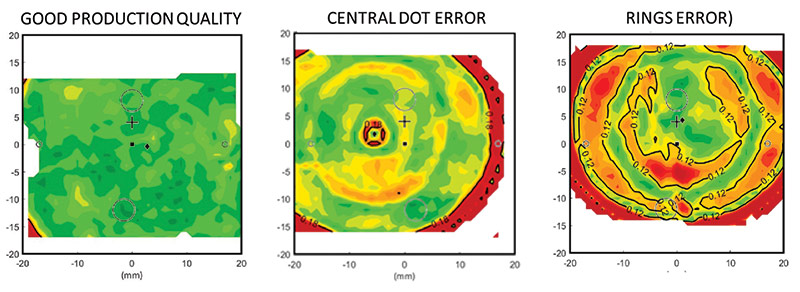Sponsored by IOT
By Deborah Kotob, ABOM
There are many steps in an ophthalmic lens journey, and each can impact lens optical quality and performance. It starts with precise refraction by the doctor utilizing calibrated equipment: next step, precision measurements taken by the optician/technician using calibrated instruments. With the first two steps fulfilled, the lab’s free-form surfacing generators apply the free-form design to the uncut lens blank.
Are you curious about the lab production process? I know I was. The first step is receiving the order and inputting it into the lab management system (LMS), which I like to think of as the controller or conductor. The lens design software (LDS) receives all the necessary information from the LMS, including the prescription, wrap, pantoscopic tilt, morphological parameters, base curve and lens material index. All of the free and fixed parameters are utilized by the LDS to compute the customized lens surface. Within a few seconds, the analysis is complete, and the LDS sends the surface file back to the LMS. The LMS uses the surface file to control the free-form computer numeric code (CNC) generator that will produce the lens surface. IOT LDS is compliant with the specifications for LDS input and output from the latest versions of the data communication standard, guaranteeing an optimum integration in the production process.

LENS MANUFACTURING PROCESS
Lens optical quality issues can occur during blocking, generating, polishing or the engraving phases. In the wearer trial “Manufacturing Errors Trial 2017,” participants compared their visual experience between correctly produced lenses and lenses made with errors. Two typical error patterns induced: central dot and rings errors.
QUALITY OF PRODUCTION
Production errors occur that degrade lens optical performance/quality just as power errors from, i.e., incorrect refraction or centration errors from inaccurate interpupillary distance measurements, degrade optical quality/performance in a lens. Quality of production is a key factor for improving wearer satisfaction. When the lens’ quality suffers, or the lens is produced off-power, the lab must determine what’s wrong. They have a partner in IOT who has the tools, technicians and experience to track the problems, recommend a solution and help the lab ensure the essential correct positioning of the engravings. When the power produced is incorrect, or the quality of the lens is off, then the lens performance declines due to central dot error and rings error. Satisfaction rates decrease for lenses with central dot error (CDE). Due to the error location in the center of the corridor, computer vision is the most affected task. Patients don’t experience the “WOW” effect. Lenses produced with rings error have similar dissatisfaction rates during the first impressions evaluation; after seven days, the satisfaction decreases dramatically. This fact indicates that production errors produce a decrease in visual quality and induce more adaptation difficulties.
Quality production impacts the wearer’s first impressions, satisfaction levels and the adaptation period. In the double-blind wearer trial Manufacturing Errors Trial 2017, “Quality production resulted in 100 percent adaptation rate within three days or less. Central dot errors saw an 11 percent rejection rate after seven days, and ring errors resulted in a 6 percent rejection rate after seven days. Moreover, the adaptation process for patients was easier, quicker and more successful with lenses produced without manufacturing errors.” Precision matters to you and your patients.
ENSURING QUALITY CONTROL
Free-form machinery has reached an astonishing level of performance, but it requires constant maintenance and control to keep quality consistent. IOT offers a quality control service. For each quality control service, IOT collects specific lens samples and does a complete power measurement evaluation of the samples, comparing them with the expected results. IOT then sends the lab a comprehensive report with these results. These full map measurements show lens quality throughout the lens, which standard lab lensmeters cannot measure.
As ECPs, I hope you have a better appreciation of the precision required in the complex multi-step production of a free-form lens and the vital role of the lens design company in evaluating the lab production process to ensure accuracy.













